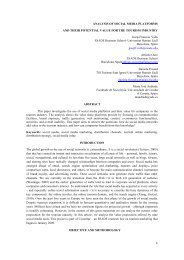customer perception of service quality in boutique hotel le six paris
customer perception of service quality in boutique hotel le six paris
customer perception of service quality in boutique hotel le six paris
You also want an ePaper? Increase the reach of your titles
YUMPU automatically turns print PDFs into web optimized ePapers that Google loves.
CUSTOMER<br />
PERCEPTION OF<br />
SERVICE QUALITY<br />
IN BOUTIQUE HOTEL<br />
LE SIX PARIS<br />
EVELYN OMANUKWUE<br />
<<br />
<<br />
<<br />
<<br />
<<br />
<<br />
<<br />
INTRODUCTION<br />
LITERATURE REVIEW<br />
METHODOLOGY<br />
FINDINGS<br />
CONCLUSION<br />
LIMITATIONS AND<br />
FUTURE RESEARCH<br />
REFERENCES
CUSTOMER PERCEPTION<br />
OF SERVICE QUALITY<br />
IN BOUTIQUE HOTEL LE SIX PARIS<br />
AUTHOR<br />
Evelyn Omanukwue<br />
eyu.eve@gmail.com<br />
Master <strong>of</strong> Science <strong>in</strong> Innovative Hospitality Management Ramon Llull University, Barcelona, Spa<strong>in</strong><br />
and Hotel Management School Maastricht, Zuyd University, Maastricht, The Netherlands<br />
ABSTRACT<br />
This study aims to exam<strong>in</strong>e <strong>customer</strong>’s <strong>perception</strong> <strong>of</strong> <strong>service</strong> <strong>quality</strong> <strong>in</strong> a Parisian <strong>boutique</strong> <strong>hotel</strong>. At the<br />
same time, <strong>customer</strong> satisfaction and <strong>customer</strong> loyalty are evaluated, as these two concepts are highly<br />
related to <strong>service</strong> <strong>quality</strong>. For this purpose a survey research has been chosen as the most appropriate<br />
research method. Data was col<strong>le</strong>cted from 151 <strong>customer</strong>s who visited <strong>boutique</strong> <strong>hotel</strong> Le Six and a<br />
benchmark has been developed to <strong>in</strong>terpret the results. The results <strong>of</strong> the study show that overall <strong>service</strong><br />
<strong>quality</strong> at <strong>hotel</strong> Le Six is highly rated by its <strong>customer</strong>s. Respondents are very satisfied with their stay,<br />
although they rema<strong>in</strong> price conscious. An additional contribution <strong>of</strong> this study is the reconfirmation <strong>of</strong> the<br />
general conceptual framework <strong>of</strong> <strong>service</strong> <strong>quality</strong> <strong>in</strong> hospitality firms by Ek<strong>in</strong>ci, Dawes and Massey (2008),<br />
<strong>in</strong> the unique sett<strong>in</strong>g <strong>of</strong> a <strong>boutique</strong> <strong>hotel</strong>.<br />
KEYWORDS<br />
Boutique <strong>hotel</strong>; <strong>service</strong> <strong>quality</strong>; <strong>customer</strong> satisfaction; <strong>customer</strong> loyalty.<br />
RESUMEN<br />
El objetivo pr<strong>in</strong>cipal de este estudio es evaluar la percepción de la calidad de servicio en un <strong>hotel</strong> situado<br />
en París. Al mismo tiempo, se evalúa también la satisfacción y la fidelidad de los clientes, ambos conceptos<br />
muy relacionados con la calidad de servicio. Para realizar este análisis. se ha considerado la encuesta<br />
como la metodología más adecuada para realizar la fase de <strong>in</strong>vestigación. Los datos se han obtenido<br />
mediante 151 encuestas realizadas a clientes que visitaron d Hotel Boutique Le Six de París y se compararon<br />
posteriormente para <strong>in</strong>terpretar los resultados. Los participantes se mostraron muy satisfechos con su<br />
estancia en el <strong>hotel</strong>, teniendo en consideración los precios abonados. La contribución de este articulo es<br />
reconfirmar el marco conceptual general de calidad de servicio de empresas <strong>hotel</strong>eras por Ek<strong>in</strong>ci, Dawes y<br />
Massey (2008), aplicado específicamente en <strong>hotel</strong>es <strong>boutique</strong>.
60 CUSTOMER PERCEPTION OF SERVICE QUALITY IN BOUTIQUE HOTEL LE SIX PARIS<br />
PALABRAS CLAVE<br />
Hotel <strong>boutique</strong>, calidad de servicio, satisfacción del diente, fidelidad del diente.
CUSTOMER PERCEPTION OF SERVICE QUALITY IN BOUTIQUE HOTEL LE SIX PARIS<br />
61<br />
INTRODUCTION<br />
Hotel Le Six is an <strong>in</strong>dependent, luxurious four star <strong>boutique</strong> <strong>hotel</strong> situated on the Paris <strong>le</strong>ft bank,<br />
between Montparnasse centre and the Luxembourg Gardens. It is with its 41 rooms categorized<br />
<strong>in</strong> classic rooms, superior rooms, deluxe rooms and suites rather small, but expensive as shown<br />
by the average rate per night <strong>of</strong> 235.26 euro (Office du Tourisme et des Congrès, 2010).<br />
As most <strong>in</strong>dustries, the Parisian <strong>hotel</strong> bus<strong>in</strong>ess has suffered severely from the worldwide 2009<br />
economic and f<strong>in</strong>ancial crisis. Recently it has recovered, reach<strong>in</strong>g pre-crisis <strong>le</strong>vels <strong>of</strong> economic<br />
parameters for which the explanation is tw<strong>of</strong>old (Office du Tourisme et des Congrès, 2010). First,<br />
the average room rates <strong>in</strong> two, three and four star <strong>hotel</strong>s have risen with respectively 3.4%, 7.6%<br />
and 4.9%. Second, the occupancy rates have improved due to the <strong>in</strong>creas<strong>in</strong>g number <strong>of</strong> foreign<br />
overnights orig<strong>in</strong>at<strong>in</strong>g from Ch<strong>in</strong>a, the rest <strong>of</strong> Asia, South-America, the Near- and the Midd<strong>le</strong> East,<br />
<strong>le</strong>ad<strong>in</strong>g to an overall 25% <strong>in</strong>crease <strong>of</strong> overnights <strong>in</strong> 2010 compared to 2009.<br />
Regard<strong>in</strong>g the average occupancy rate, it is important to note that on average cha<strong>in</strong> <strong>hotel</strong>s<br />
(79.4%) have a better occupancy rate than <strong>in</strong>dependent <strong>hotel</strong>s (75.7%) (Office du Tourisme et des<br />
Congrès, 2010). Moreover, the general ownership <strong>of</strong> Parisian <strong>hotel</strong>s is shift<strong>in</strong>g significantly; <strong>in</strong> the<br />
period 2000-2011 the share <strong>of</strong> availab<strong>le</strong> rooms belong<strong>in</strong>g to cha<strong>in</strong> <strong>hotel</strong>s <strong>in</strong>creased from 28.1% to<br />
40.8%. Tak<strong>in</strong>g these trends <strong>in</strong>to account, competition <strong>in</strong> the Parisian <strong>hotel</strong> <strong>in</strong>dustry is <strong>in</strong>tensify<strong>in</strong>g.<br />
Furthermore, <strong>in</strong>dependent <strong>hotel</strong>s seem to lose out from cha<strong>in</strong> <strong>hotel</strong>s. Note that <strong>hotel</strong> Le Six is a<br />
privately owned <strong>hotel</strong>, which puts it <strong>in</strong> a weaker position compared to luxurious cha<strong>in</strong> <strong>hotel</strong>s.<br />
How then can the management <strong>of</strong> a Parisian <strong>boutique</strong> <strong>hotel</strong> like <strong>hotel</strong> Le Six susta<strong>in</strong> and improve<br />
its market position? From the literature, an apparently positive relationship exists between<br />
the <strong>quality</strong> <strong>of</strong> the <strong>service</strong>s <strong>of</strong>fered and the success <strong>of</strong> a <strong>service</strong> firm. Service <strong>quality</strong> promotes<br />
<strong>customer</strong> satisfaction, which can <strong>le</strong>ad to the attraction <strong>of</strong> new <strong>customer</strong>s and the improvement<br />
<strong>of</strong> the loyalty <strong>of</strong> exist<strong>in</strong>g <strong>customer</strong>s. Thus, <strong>service</strong> <strong>quality</strong> will potentially safeguard the competitive<br />
position <strong>of</strong> <strong>service</strong> firms (Pizam and Ellis, 1999; Akbaba, 2006). Therefore, <strong>in</strong> order to be<br />
susta<strong>in</strong>ab<strong>le</strong> and <strong>in</strong>crease its success, it is important for the management <strong>of</strong> <strong>boutique</strong> <strong>hotel</strong> Le Six<br />
to research on <strong>service</strong> <strong>quality</strong>.<br />
LITERATURE REVIEW<br />
To develop the context for this research, different constructs are discussed and are brought together<br />
<strong>in</strong> the conceptual framework.<br />
BOUTIQUE HOTEL<br />
Besides different attempts towards a comprehensive def<strong>in</strong>ition <strong>of</strong> the concept <strong>boutique</strong> <strong>hotel</strong>, the<br />
majority <strong>of</strong> practitioners and researchers have reached consensus regard<strong>in</strong>g the most important<br />
def<strong>in</strong><strong>in</strong>g characteristics <strong>of</strong> <strong>boutique</strong> <strong>hotel</strong>s <strong>in</strong>clud<strong>in</strong>g size, location, architecture and design, <strong>service</strong>s<br />
and <strong>quality</strong> provided.<br />
size: Boutique <strong>hotel</strong>s are generally smal<strong>le</strong>r <strong>in</strong> size than traditional <strong>hotel</strong>s, with <strong>le</strong>ss than 100<br />
rooms (Erkutlu and Chafra, 2005). Recently though, larger cha<strong>in</strong>s are try<strong>in</strong>g to compete <strong>in</strong> this
62 CUSTOMER PERCEPTION OF SERVICE QUALITY IN BOUTIQUE HOTEL LE SIX PARIS<br />
market by start<strong>in</strong>g up <strong>hotel</strong> brands that are different and unique. The well-known W brand <strong>of</strong><br />
Starwood is an examp<strong>le</strong> <strong>of</strong> this venture (Lim and Edean, 2009). Yet, the majority <strong>of</strong> <strong>boutique</strong> <strong>hotel</strong>s<br />
are privately owned, <strong>in</strong>dependent <strong>hotel</strong>s, thereby contribut<strong>in</strong>g to their <strong>in</strong>dividual and unique<br />
character (McIntosh and Siggs, 2005). Lim et al. (2009) disagree claim<strong>in</strong>g that the ownership <strong>of</strong><br />
<strong>boutique</strong> <strong>hotel</strong>s is evenly split among private and group enterprises.<br />
appeal<strong>in</strong>g location: Boutique <strong>hotel</strong>s are generally found <strong>in</strong> trendy neighbourhoods <strong>of</strong> suburban<br />
areas or city centres (Lim et al., 2009; Albazzaz et al., 2003). Nowadays, the concept is also <strong>in</strong>troduced<br />
<strong>in</strong> rural locations and resort dest<strong>in</strong>ations.<br />
architecture and design: Boutique <strong>hotel</strong>s are commonly situated <strong>in</strong> historical build<strong>in</strong>gs and sites<br />
or build<strong>in</strong>gs with <strong>in</strong>terest<strong>in</strong>g architectural aspects (Agett, 2007; McIntosh et al., 2005; Lim et al.,<br />
2009). Furthermore, the <strong>in</strong>terior is tailored to the personality <strong>of</strong> the build<strong>in</strong>g with stylish, deluxe,<br />
design furniture; sometimes themes are <strong>in</strong>corporated as well, for examp<strong>le</strong> the decoration <strong>of</strong> each<br />
room might be based upon the works <strong>of</strong> a well-known pa<strong>in</strong>ter (Lim et al., 2009; Erkutlu et al., 2005).<br />
<strong>service</strong>: Boutique <strong>hotel</strong>s have a high staff-to-guest ratio, allow<strong>in</strong>g them to provide a personalized<br />
<strong>service</strong> (Lim et al., 2009; Erkutlu et al., 2005). Guests can be attended to 24/7 by the <strong>hotel</strong><br />
staff, giv<strong>in</strong>g each guest a special and unique feel<strong>in</strong>g throughout his/her stays. Interaction between<br />
staff and guests is more familiar, creat<strong>in</strong>g a more relaxed and homely environment (Agett, 2007;<br />
McIntosh et al., 2005). Besides, most <strong>boutique</strong> <strong>hotel</strong>s provide exclusive facilities like good <strong>quality</strong><br />
restaurants, bars and lounges and spa’s as an <strong>in</strong>tegral feature <strong>of</strong> their <strong>service</strong>. Furthermore, hightech<br />
amenities such as high-speed Internet access, cord<strong>le</strong>ss phones, CD players, libraries <strong>of</strong> music<br />
and books are <strong>of</strong>fered (Albazzaz et al., 2003).<br />
<strong>quality</strong>: In every aspect <strong>of</strong> <strong>boutique</strong> <strong>hotel</strong>s – food and beverage, <strong>in</strong>terior design, <strong>service</strong>s provided<br />
et cetera – the aim is to reach or even surpass the common <strong>quality</strong> standards laid out. Accord<strong>in</strong>g<br />
to Agett (2007) and McIntosh et al. (2005), clients are attracted to <strong>boutique</strong> <strong>hotel</strong>s because<br />
<strong>of</strong> their <strong>quality</strong> image.<br />
In conclusion, the ma<strong>in</strong> aim <strong>of</strong> <strong>boutique</strong> <strong>hotel</strong>s is to <strong>of</strong>fer their clients a unique experience<br />
through the pursuit <strong>of</strong> a unique environment, extraord<strong>in</strong>ary features and personalized <strong>service</strong>.<br />
Nowadays, clients are will<strong>in</strong>g to pay more for the extraord<strong>in</strong>ary feel<strong>in</strong>g <strong>of</strong>fered by <strong>boutique</strong> <strong>hotel</strong>s.<br />
SERVICE QUALITY<br />
Service <strong>quality</strong> is an elusive concept that is difficult to def<strong>in</strong>e and measure. Earlier studies def<strong>in</strong>ed<br />
<strong>quality</strong> as conformance to specifications, imply<strong>in</strong>g that the feature set <strong>of</strong> a product should match<br />
the standards predeterm<strong>in</strong>ed by the management (Reeves and Bednar, 1994). However, such a<br />
management <strong>in</strong>spired def<strong>in</strong>ition can hardly be applied to quantify <strong>service</strong> <strong>quality</strong> because <strong>service</strong>s<br />
are difficult to reduce to a set <strong>of</strong> standards. Consequently, more suitab<strong>le</strong> def<strong>in</strong>itions <strong>of</strong> <strong>quality</strong><br />
have been developed, characterized by a consumer’s perspective. Scholars have def<strong>in</strong>ed <strong>quality</strong><br />
<strong>in</strong> three dist<strong>in</strong>ct ways: <strong>quality</strong> as excel<strong>le</strong>nce, <strong>quality</strong> as value and <strong>quality</strong> as meet<strong>in</strong>g or<br />
exceed<strong>in</strong>g expectations (Ek<strong>in</strong>ci, 2008).<br />
Accord<strong>in</strong>g to Ek<strong>in</strong>ci (2008), the term ‘excel<strong>le</strong>nce’ <strong>in</strong> the first def<strong>in</strong>ition is highly subjective and<br />
thus difficult to measure objectively. Second, ‘<strong>quality</strong> as value’ implies that perceived <strong>quality</strong><br />
equals perceived value. However, Bolton and Drew (1991) are ab<strong>le</strong> to differentiate value from<br />
<strong>quality</strong> by <strong>in</strong>troduc<strong>in</strong>g price. They claim that perceived value is def<strong>in</strong>ed by the <strong>customer</strong>s’ trade-
CUSTOMER PERCEPTION OF SERVICE QUALITY IN BOUTIQUE HOTEL LE SIX PARIS<br />
63<br />
<strong>of</strong>f between benefits and costs. The benefit component might be the same as <strong>quality</strong> and thus the<br />
perceived value is determ<strong>in</strong>ed by compar<strong>in</strong>g the perceived <strong>quality</strong> to the price paid. F<strong>in</strong>ally, the<br />
third def<strong>in</strong>ition <strong>of</strong> ‘<strong>quality</strong> as meet<strong>in</strong>g or exceed<strong>in</strong>g expectations’ is broader and more consumerfriendly,<br />
accord<strong>in</strong>g to Ek<strong>in</strong>ci (2008). Recent literature suggests that <strong>service</strong> <strong>quality</strong> is <strong>in</strong>deed the<br />
subjective assessment <strong>of</strong> <strong>service</strong> performance by consumers themselves (Dabholkar, Shepherd and<br />
Thorpe, 2000) and thus confirms the last def<strong>in</strong>ition.<br />
Different models <strong>of</strong> <strong>service</strong> <strong>quality</strong> have been <strong>in</strong>troduced by different scholars. The majority<br />
considers <strong>service</strong> <strong>quality</strong> as a multidimensional concept; however no consensus has been reached<br />
yet regard<strong>in</strong>g the underly<strong>in</strong>g generic and specific dimensions <strong>of</strong> <strong>service</strong> <strong>quality</strong> (Ek<strong>in</strong>ci, 2008). The<br />
current debate is dom<strong>in</strong>ated by two research streams: the North American versus the Nordic<br />
European school <strong>of</strong> thought.<br />
SERVQUAL, developed by scholars from the North American school <strong>of</strong> thought is the best known<br />
<strong>customer</strong>-oriented model used to measure <strong>service</strong> <strong>quality</strong> (Parasuraman, Zeithaml and Berry,<br />
1988). It measures the gap between <strong>customer</strong> expectations and their <strong>perception</strong>s <strong>of</strong> the actual<br />
experience on a five dimensional sca<strong>le</strong>: tangib<strong>le</strong>s, reliability, responsiveness, empathy, assurance.<br />
However, these dimensions have shown to be <strong>in</strong>dist<strong>in</strong>ct and other models <strong>of</strong> <strong>service</strong> <strong>quality</strong> have<br />
shown to be more parsimonious (Carmen, 1990). Moreover, new dimensions have been found whi<strong>le</strong><br />
apply<strong>in</strong>g the SERVQUAL model <strong>in</strong> diverse <strong>in</strong>dustries.<br />
In contrast, supporters <strong>of</strong> the Nordic European school <strong>of</strong> thought have developed other wellknown<br />
models <strong>of</strong> <strong>service</strong> <strong>quality</strong> based on three dimensions cal<strong>le</strong>d physical <strong>quality</strong>, <strong>in</strong>teraction<br />
<strong>quality</strong> and output <strong>quality</strong>. Service <strong>quality</strong> is determ<strong>in</strong>ed by what <strong>customer</strong>s obta<strong>in</strong> from a <strong>service</strong><br />
firm and how <strong>customer</strong>s obta<strong>in</strong> <strong>service</strong>s. Accord<strong>in</strong>g to Brady and Cron<strong>in</strong> (2001), these models<br />
were more valid when applied to different <strong>service</strong> <strong>in</strong>dustries.<br />
Follow<strong>in</strong>g the Nordic school, Ek<strong>in</strong>ci (2008) has developed a highly reliab<strong>le</strong> multi-dimensional and<br />
multi-<strong>le</strong>vel model <strong>of</strong> <strong>service</strong> <strong>quality</strong> for hospitality firms. Accord<strong>in</strong>g to the author, <strong>service</strong> <strong>quality</strong><br />
consists <strong>of</strong> primary and secondary dimensions. Two primary dimensions have been dist<strong>in</strong>guished:<br />
output <strong>quality</strong> and <strong>in</strong>teraction <strong>quality</strong>. Both dimensions are split up <strong>in</strong>to secondary dimensions.<br />
Output <strong>quality</strong> consists <strong>of</strong> physical <strong>quality</strong> and product <strong>quality</strong>, whi<strong>le</strong> <strong>in</strong>teractive <strong>quality</strong> is composed<br />
<strong>of</strong> staff behaviour and responsiveness. Depend<strong>in</strong>g on the type <strong>of</strong> hospitality <strong>service</strong> be<strong>in</strong>g researched,<br />
each secondary dimension can be split up <strong>in</strong>to specific attributes that can be measured.<br />
CUSTOMER SATISFACTION<br />
Customer satisfaction and dissatisfaction have attracted the attention <strong>of</strong> many scholars <strong>le</strong>ad<strong>in</strong>g<br />
to the development <strong>of</strong> different conceptualizations <strong>of</strong> satisfaction. Two common <strong>in</strong>terpretations<br />
can be dist<strong>in</strong>guished: transient and overall satisfaction (Ek<strong>in</strong>ci et al., 2008).<br />
First, transient or transaction-specific satisfaction evaluates each s<strong>in</strong>g<strong>le</strong> <strong>service</strong> encounter.<br />
Hotels <strong>of</strong>fer many <strong>service</strong>s to their <strong>customer</strong>s, rang<strong>in</strong>g from spa facilities to room <strong>service</strong>, thus<br />
<strong>customer</strong>s encounter many <strong>service</strong>s dur<strong>in</strong>g their stay. Consequently, the researcher should capture<br />
the <strong>customer</strong> satisfaction after each encounter.<br />
Second, overall satisfaction gathers, accord<strong>in</strong>g to a mathematical function, all transient satisfactions<br />
a <strong>customer</strong> experienced dur<strong>in</strong>g his stay. Next, performance satisfaction is def<strong>in</strong>ed as the<br />
overall satisfaction compared to one or multip<strong>le</strong> standards. Anderson and Fornell (1994) underl<strong>in</strong>ed
64 CUSTOMER PERCEPTION OF SERVICE QUALITY IN BOUTIQUE HOTEL LE SIX PARIS<br />
the popularity among researchers <strong>of</strong> the overall satisfaction theory because <strong>of</strong> its relation with<br />
consumers’ <strong>in</strong>tentions and bus<strong>in</strong>ess performance. However, Oliver (1980) found overall satisfaction<br />
as a function <strong>of</strong> transient experiences rather difficult to measure and argued its unsuitability<br />
<strong>in</strong> a <strong>service</strong> context with three arguments. First, overall satisfaction regresses fast towards the<br />
overall attitude the <strong>customer</strong> has <strong>of</strong> the firm researched. Second, <strong>customer</strong>s f<strong>in</strong>d it hard to remember<br />
without any bias the satisfaction <strong>le</strong>vel <strong>of</strong> their first <strong>service</strong> encounter when experienc<strong>in</strong>g<br />
multip<strong>le</strong> encounters. Third, <strong>customer</strong>s might lack the resources to experience multip<strong>le</strong> <strong>service</strong><br />
encounters with a specific firm.<br />
Recently, researchers have transcended the paradigmatic discussion between transient and<br />
overall satisfaction and started focus<strong>in</strong>g on the affective nature <strong>of</strong> satisfaction (Giese and Cote,<br />
2000). Illustratively, Oliver (1997, p. 13) states that ‘satisfaction is the consumer’s fulfilment response.<br />
It is a judgement that a product or <strong>service</strong> feature, or the product or <strong>service</strong> itself, provided<br />
(or is provid<strong>in</strong>g) a p<strong>le</strong>asurab<strong>le</strong> <strong>le</strong>vel <strong>of</strong> consumption-related fulfilment, <strong>in</strong>clud<strong>in</strong>g <strong>le</strong>vels <strong>of</strong><br />
under- or over fulfilment’. Customer satisfaction is thus def<strong>in</strong>ed as the ‘consumer’s overall emotional<br />
response to the entire <strong>service</strong> experience for a s<strong>in</strong>g<strong>le</strong> transaction at the post-purchas<strong>in</strong>g<br />
po<strong>in</strong>t’ (Ek<strong>in</strong>ci et al., 2008, p. 40). The appropriateness <strong>of</strong> this def<strong>in</strong>ition for evaluat<strong>in</strong>g <strong>service</strong>s is<br />
tw<strong>of</strong>old: <strong>service</strong>s are <strong>in</strong>tangib<strong>le</strong> and the response <strong>of</strong> <strong>customer</strong>s can best be captured after consumption.<br />
CUSTOMER LOYALTY<br />
Customer loyalty and retention have been an important focus <strong>of</strong> many organisations <strong>in</strong> their pursuit<br />
to rema<strong>in</strong> competitive. Oliver (1997, p. 392) def<strong>in</strong>es <strong>customer</strong> loyalty as ‘a deeply held commitment<br />
to re-buy or re-patronise a preferred product or <strong>service</strong> consistently <strong>in</strong> the future despite<br />
situational <strong>in</strong>fluence and market<strong>in</strong>g efforts hav<strong>in</strong>g the potential to cause switch<strong>in</strong>g behaviour’.<br />
Accord<strong>in</strong>g to Anderson and Jacobsen (2000, p. 67), <strong>customer</strong> loyalty is ‘the result <strong>of</strong> an organisation<br />
creat<strong>in</strong>g a benefit for <strong>customer</strong>s so that they will ma<strong>in</strong>ta<strong>in</strong> or <strong>in</strong>crease their purchases from<br />
the organisation’. Likewise, Z<strong>in</strong>eld<strong>in</strong> (2000) refers to <strong>customer</strong> retention as the urge <strong>of</strong> an <strong>in</strong>dividual<br />
to do bus<strong>in</strong>ess with a particular company cont<strong>in</strong>uously. Accord<strong>in</strong>g to Hoyer and MacInnis<br />
(2008, p. 289), <strong>customer</strong> retention is ‘the practice <strong>of</strong> work<strong>in</strong>g to satisfy <strong>customer</strong>s with the <strong>in</strong>tention<br />
<strong>of</strong> develop<strong>in</strong>g long-term relationships with them’. Thus, <strong>customer</strong> loyalty is achieved when<br />
<strong>customer</strong>s are will<strong>in</strong>g to re-purchase or re-use a same good/<strong>service</strong> because <strong>of</strong> the qualities <strong>of</strong> the<br />
good/<strong>service</strong> itself.<br />
In conclusion, three conceptualizations <strong>of</strong> <strong>customer</strong> loyalty exist: s<strong>in</strong>gular, additive or <strong>in</strong>teractive,<br />
whereby <strong>customer</strong> loyalty is <strong>in</strong>terpreted as respectively an attitude, a behaviour or a comb<strong>in</strong>ation<br />
<strong>of</strong> both towards the product/<strong>service</strong> at stake (East, Gendall, Hammond and Lomax, 2005).<br />
Recommendation is an attitude, whereas retention and search are behaviours. Accord<strong>in</strong>g to East<br />
et al. (2005), one should be careful when comb<strong>in</strong><strong>in</strong>g attitudes and behaviours, they strongly advise<br />
to measure <strong>customer</strong> loyalty as a s<strong>in</strong>gular concept. However, <strong>in</strong> this study <strong>customer</strong> loyalty is<br />
considered as an <strong>in</strong>teractive concept <strong>of</strong> attitude and behaviour, yet the researcher carefully aggregates<br />
both.
CUSTOMER PERCEPTION OF SERVICE QUALITY IN BOUTIQUE HOTEL LE SIX PARIS<br />
65<br />
CONCEPTUAL FRAMEWORK<br />
The relationships between <strong>service</strong> <strong>quality</strong>, <strong>customer</strong> satisfaction and <strong>customer</strong> loyalty are visualised<br />
<strong>in</strong> the conceptual framework (see Figure 1) and expla<strong>in</strong>ed underneath.<br />
F IGURE 1. Conceptual framework<br />
Physical Quality<br />
Product Quality<br />
Staff Behaviour<br />
Responsiveness<br />
Service Quality<br />
Customer<br />
Retention<br />
Customer<br />
Recommendation<br />
Customer Satisfaction<br />
Customer Loyalty<br />
Desired Self-Congruence<br />
An obvious l<strong>in</strong>k exists between <strong>service</strong> <strong>quality</strong> and <strong>customer</strong> satisfaction; however the direction<br />
<strong>of</strong> the relationship rema<strong>in</strong>s doubtful. On the one hand scholars (e.g. Vavra, 1997) argue that <strong>service</strong><br />
<strong>quality</strong> is reached when <strong>customer</strong>s are satisfied with the <strong>service</strong>s <strong>of</strong>fered. On the other hand<br />
<strong>service</strong> <strong>quality</strong> is seen as an antecedent <strong>of</strong> <strong>customer</strong> satisfaction (Oliver, 1993). Recently, evidence<br />
has been found to verify this last unilateral direction (Dabholkar et al., 2000). Therefore, <strong>in</strong> this<br />
research <strong>service</strong> <strong>quality</strong> compris<strong>in</strong>g the secondary dimensions physical <strong>quality</strong>, product <strong>quality</strong>,<br />
staff behaviour and responsiveness, is considered as an antecedent <strong>of</strong> <strong>customer</strong> satisfaction.<br />
Besides <strong>service</strong> <strong>quality</strong>, the self-concept has proven to <strong>in</strong>fluence <strong>customer</strong> satisfaction. Selfconcept<br />
is a ref<strong>le</strong>ction <strong>of</strong> how an <strong>in</strong>dividual sees himself. Research has shown that consumers<br />
prefer products and <strong>service</strong>s that are congruent with their self-concept; for <strong>in</strong>stance Graeff (1996)<br />
found that <strong>customer</strong>s have more positive attitudes to brands that are <strong>in</strong> l<strong>in</strong>e with their self-concept.<br />
Note that self-concept is multidimensional, but only two dimensions – ideal and desired selfcongruence<br />
– have proven to be highly significant as antecedents <strong>of</strong> <strong>customer</strong> satisfaction (Ek<strong>in</strong>ci<br />
et al., 2008). Ideal self-congruence is the image <strong>of</strong> oneself as one would like it to be (Landon,<br />
1974). Desired self-congruence <strong>in</strong>duces goals and desires as reference po<strong>in</strong>ts (Sirgy et al., 1997).<br />
However, the ma<strong>in</strong> focus <strong>of</strong> this research is on the <strong>quality</strong> <strong>of</strong> the <strong>service</strong>s <strong>of</strong>fered by <strong>boutique</strong><br />
<strong>hotel</strong> Le Six, thus only desired self-congruence is considered as an antecedent <strong>of</strong> <strong>customer</strong> satisfaction,<br />
besides <strong>service</strong> <strong>quality</strong>.<br />
The most common consequence <strong>of</strong> <strong>customer</strong> satisfaction is known as <strong>customer</strong> loyalty, <strong>in</strong>clud<strong>in</strong>g<br />
the <strong>in</strong>tention to recommend and the <strong>in</strong>tention to return to the <strong>service</strong> firm. Evidence has been<br />
provided that <strong>in</strong>tention to return – def<strong>in</strong>ed as ‘a consumer’s likelihood <strong>of</strong> re-purchas<strong>in</strong>g the same<br />
<strong>service</strong>’ (Ek<strong>in</strong>ci et al., 2008, p. 44) – is positively <strong>in</strong>fluenced by satisfaction and the consumers’
66 CUSTOMER PERCEPTION OF SERVICE QUALITY IN BOUTIQUE HOTEL LE SIX PARIS<br />
overall attitude towards a <strong>service</strong> firm (Szymanski and Henard, 2001). Note that the overall satisfaction<br />
<strong>of</strong> a <strong>customer</strong> is an emotional response towards a <strong>service</strong> encounter whi<strong>le</strong> the overall<br />
attitude is the ref<strong>le</strong>ction <strong>of</strong> the image a <strong>customer</strong> has <strong>of</strong> a firm. Consequently, <strong>customer</strong>s with a<br />
positive attitude towards a <strong>service</strong> firm are more likely to return. Neverthe<strong>le</strong>ss, a consumer’s<br />
overall attitude falls beyond the scope <strong>of</strong> this research and thus only overall satisfaction is considered<br />
as an antecedent <strong>of</strong> <strong>customer</strong> loyalty. As mentioned above, <strong>customer</strong> loyalty is def<strong>in</strong>ed as<br />
an <strong>in</strong>teractive concept <strong>of</strong> <strong>in</strong>tention to return and recommendation.<br />
METHODOLOGY<br />
In this study survey research is used, allow<strong>in</strong>g the researcher to obta<strong>in</strong> a large amount <strong>of</strong> data<br />
from the researched population (Neuman, 2006; Alt<strong>in</strong>ay and Paraskevas, 2008). As such, the researcher<br />
is ab<strong>le</strong> to measure the dimensions <strong>of</strong> <strong>service</strong> <strong>quality</strong>, <strong>customer</strong> satisfaction and <strong>customer</strong><br />
loyalty <strong>in</strong> <strong>boutique</strong> <strong>hotel</strong> Le Six. Moreover, the relationships between these concepts are<br />
verified. F<strong>in</strong>ally, the performed analysis allows the researcher to objectively draw conclusions.<br />
A samp<strong>le</strong> <strong>of</strong> respondents has been generated from the researched population by us<strong>in</strong>g a nonprobability<br />
sampl<strong>in</strong>g, more specifically the convenience sampl<strong>in</strong>g technique (Alt<strong>in</strong>ay et al., 2008).<br />
Thus, the most approachab<strong>le</strong> <strong>hotel</strong> visitors form the samp<strong>le</strong> <strong>of</strong> the researched population, <strong>le</strong>av<strong>in</strong>g<br />
it to the <strong>in</strong>dividual’s will<strong>in</strong>gness to participate <strong>in</strong> the study. The data have been col<strong>le</strong>cted <strong>in</strong> French<br />
and English to avoid the exclusion <strong>of</strong> many potential respondents. F<strong>in</strong>ally, the samp<strong>le</strong> consists <strong>of</strong><br />
151 respondents, a samp<strong>le</strong> size that allows the researcher to statistically analyse the data.<br />
The content <strong>of</strong> the <strong>in</strong>itial questionnaire was pre-tested with col<strong>le</strong>agues <strong>of</strong> the front desk and<br />
fifteen respondents. Then, the revised questionnaire was distributed to <strong>hotel</strong> visitors at the end<br />
<strong>of</strong> their stay, a day before check-out. As such, the <strong>customer</strong>s were ab<strong>le</strong> to evaluate their <strong>le</strong>vel <strong>of</strong><br />
satisfaction. The questionnaire evaluates four theoretical concepts: <strong>service</strong> <strong>quality</strong>, overall consumer<br />
satisfaction, desired self-congruence and <strong>customer</strong> loyalty. Remark that <strong>service</strong> <strong>quality</strong> is<br />
measured along five dimensions: physical <strong>quality</strong>, product <strong>quality</strong>, staff behaviour, responsiveness<br />
and overall <strong>service</strong> <strong>quality</strong>. Also, personal <strong>in</strong>formation from the respondents is gathered at the<br />
beg<strong>in</strong>n<strong>in</strong>g <strong>of</strong> the questionnaire.<br />
As already mentioned above, the ma<strong>in</strong> purpose <strong>of</strong> this study is to <strong>in</strong>vestigate the <strong>le</strong>vel <strong>of</strong> <strong>service</strong><br />
<strong>quality</strong>, <strong>customer</strong> satisfaction and <strong>customer</strong> loyalty <strong>in</strong> <strong>boutique</strong> <strong>hotel</strong> Le Six. Consequently,<br />
report<strong>in</strong>g descriptive statistics per question suffices to draw helpful conclusions for the <strong>hotel</strong><br />
management.<br />
In addition to the research specially performed for the <strong>hotel</strong> management <strong>of</strong> <strong>boutique</strong> <strong>hotel</strong> Le<br />
Six, the existence <strong>of</strong> the relationships between <strong>service</strong> <strong>quality</strong>, desired self-congruence, <strong>customer</strong><br />
satisfaction and <strong>customer</strong> loyalty is verified. In order to obta<strong>in</strong> this goal, correlations are calculated.<br />
It should be remarked that the data <strong>of</strong> these theoretical concepts are discrete and nonnormally<br />
distributed and therefore the Spearman’s method is chosen to calculate the correlations.
CUSTOMER PERCEPTION OF SERVICE QUALITY IN BOUTIQUE HOTEL LE SIX PARIS<br />
67<br />
FINDINGS<br />
Hotel Le Six is ma<strong>in</strong>ly visited by tourists orig<strong>in</strong>at<strong>in</strong>g from English speak<strong>in</strong>g countries, who highly<br />
perceive the <strong>quality</strong> <strong>of</strong> the <strong>service</strong>s <strong>of</strong>fered. Among the four <strong>service</strong> <strong>quality</strong> dimensions (physical<br />
<strong>quality</strong>, product <strong>quality</strong>, staff behaviour, responsiveness), product <strong>quality</strong> was by far the <strong>le</strong>ast<br />
appreciated.<br />
Clients <strong>of</strong> <strong>hotel</strong> Le Six, highly appreciate the overall <strong>quality</strong> <strong>of</strong> the <strong>service</strong>s <strong>of</strong>fered. These answers<br />
allow us to conclude that <strong>boutique</strong> <strong>hotel</strong> Le Six has reached its ma<strong>in</strong> aim <strong>in</strong> <strong>of</strong>fer<strong>in</strong>g high-end<br />
<strong>quality</strong> <strong>service</strong>s to its diverse cliente<strong>le</strong>. Although m<strong>in</strong>or remarks are made at <strong>in</strong>dividual measurements,<br />
overall clients seem to enjoy the unique atmosphere created by the architecture, <strong>in</strong>terior,<br />
products <strong>of</strong>fered and staff behaviour <strong>in</strong> <strong>hotel</strong> Le Six.<br />
Furthermore, respondents are very satisfied regard<strong>in</strong>g the <strong>service</strong>s <strong>of</strong>fered by <strong>boutique</strong> <strong>hotel</strong><br />
Le Six. However, the price consciousness <strong>of</strong> <strong>customer</strong>s is obviously present even though <strong>hotel</strong> Le<br />
Six attracts high-end <strong>customer</strong>s. Clients are will<strong>in</strong>g to pay a much higher price than for the average<br />
<strong>hotel</strong> <strong>in</strong> the neighbourhood, but they also want to get the best possib<strong>le</strong> <strong>service</strong>. Therefore,<br />
<strong>hotel</strong> Le Six’s management should bear this price sensitivity <strong>of</strong> their <strong>customer</strong> base <strong>in</strong> m<strong>in</strong>d; <strong>service</strong><br />
<strong>quality</strong> should not dim<strong>in</strong>ish, if there is no price decrease.<br />
Overall, <strong>service</strong>s and treatments are received as desired. However, some ambiguity rema<strong>in</strong>s<br />
when <strong>in</strong>terpret<strong>in</strong>g the disunity among the respondents and the sometimes illogical consecutive<br />
scores concern<strong>in</strong>g the desired self-congruence questions. Unfortunately, no comments were <strong>le</strong>ft<br />
expla<strong>in</strong><strong>in</strong>g the extremely positive feel<strong>in</strong>g.<br />
F<strong>in</strong>ally, the visitors <strong>of</strong> <strong>hotel</strong> Le Six are not the most loyal ones. The disloyalty is driven by retention<br />
rather than by recommendation; behaviours seem more difficult to <strong>in</strong>fluence than attitudes.<br />
Two reasons can expla<strong>in</strong> the difficulties faced when try<strong>in</strong>g to change behaviour. First, <strong>hotel</strong> Le<br />
Six is ma<strong>in</strong>ly visited by tourists from other cont<strong>in</strong>ents. These visitors will most likely not revisit<br />
Paris <strong>in</strong> the short term. Moreover, when return<strong>in</strong>g to Paris, they might prefer to stay <strong>in</strong> another<br />
part <strong>of</strong> town. Second, visitors attracted once by the unique characteristics <strong>of</strong> a <strong>boutique</strong><br />
<strong>hotel</strong>, are probably <strong>le</strong>ss likely to re-visit the same sett<strong>in</strong>g as their choice is based on unique and<br />
alternative experiences.<br />
Test<strong>in</strong>g the conceptual framework allows the researcher to draw the follow<strong>in</strong>g conclusions.<br />
Customers highly appreciat<strong>in</strong>g the behaviour <strong>of</strong> staff will probably appreciate the overall <strong>service</strong><br />
<strong>quality</strong>. Thus, efforts to <strong>in</strong>crease the overall <strong>service</strong> <strong>quality</strong> will have the most effect when target<strong>in</strong>g<br />
a change <strong>of</strong> staff behaviour rather than a change <strong>of</strong> physical <strong>quality</strong>, product <strong>quality</strong> or responsiveness.<br />
Moreover, <strong>customer</strong>s overall appreciative <strong>of</strong> the <strong>service</strong>s are more likely to be<br />
satisfied and as such will show more loyal behaviour and attitude towards the <strong>service</strong> firm.<br />
CONCLUSION<br />
The aim <strong>of</strong> this study was to <strong>in</strong>vestigate <strong>customer</strong>’s <strong>perception</strong> <strong>of</strong> <strong>service</strong> <strong>quality</strong> <strong>in</strong> <strong>boutique</strong><br />
<strong>hotel</strong> Le Six. In the first place a theoretical framework for <strong>service</strong> <strong>quality</strong> <strong>in</strong> <strong>boutique</strong> <strong>hotel</strong>s was<br />
developed based on an extended literature review. After def<strong>in</strong><strong>in</strong>g the different concepts, an already<br />
empirically validated questionnaire measur<strong>in</strong>g <strong>service</strong> <strong>quality</strong> for hospitality firms, was modified
68 CUSTOMER PERCEPTION OF SERVICE QUALITY IN BOUTIQUE HOTEL LE SIX PARIS<br />
to suit the context <strong>of</strong> <strong>boutique</strong> <strong>hotel</strong>s. Next, data were gathered from <strong>hotel</strong> visitors us<strong>in</strong>g the adjusted<br />
questionnaire. Analys<strong>in</strong>g the data allowed the researcher to draw conclusions and give<br />
recommendations to <strong>hotel</strong> Le Six.<br />
Overall, the <strong>quality</strong> <strong>of</strong> the <strong>service</strong>s <strong>of</strong>fered by <strong>boutique</strong> <strong>hotel</strong> Le Six is very high. Three <strong>of</strong> the<br />
four secondary dimensions (physical <strong>quality</strong>, staff behaviour and responsiveness) have determ<strong>in</strong>ed<br />
this positive <strong>perception</strong>. In contrast, the product <strong>quality</strong> dimension is relatively poorly<br />
perceived.<br />
From test<strong>in</strong>g the conceptual framework, the researcher can conclude that the <strong>perception</strong> <strong>of</strong><br />
<strong>service</strong> <strong>quality</strong> is best ref<strong>le</strong>cted by the <strong>perception</strong> <strong>of</strong> staff behaviour. Moreover, <strong>customer</strong> loyalty<br />
is a direct result <strong>of</strong> <strong>customer</strong> satisfaction. F<strong>in</strong>ally, <strong>customer</strong> satisfaction is best ref<strong>le</strong>cted by the<br />
<strong>perception</strong> <strong>of</strong> overall <strong>service</strong> <strong>quality</strong>; desired self-congruence only plays a m<strong>in</strong>or ro<strong>le</strong>.<br />
Ultimately, the <strong>hotel</strong> management wants to improve the loyalty <strong>of</strong> <strong>customer</strong>s, which can be<br />
achieved by improv<strong>in</strong>g <strong>customer</strong> satisfaction and consequently overall <strong>service</strong> <strong>quality</strong>. The <strong>le</strong>vel<br />
<strong>of</strong> overall <strong>service</strong> <strong>quality</strong> is determ<strong>in</strong>ed by four dimensions which are under the control <strong>of</strong> the<br />
<strong>hotel</strong> management. As such, an <strong>in</strong>direct relationship exists between the four <strong>service</strong> <strong>quality</strong> dimensions<br />
and <strong>customer</strong> loyalty. Thus, the <strong>le</strong>vel <strong>of</strong> <strong>customer</strong> loyalty can be <strong>in</strong>creased by ameliorat<strong>in</strong>g<br />
the means or improv<strong>in</strong>g the skewness (decreas<strong>in</strong>g the standard deviation) <strong>of</strong> the <strong>service</strong> <strong>quality</strong><br />
dimensions. Moreover, the f<strong>in</strong>d<strong>in</strong>gs from the calculated correlations suggest priorities <strong>in</strong><br />
improv<strong>in</strong>g <strong>customer</strong> loyalty. The <strong>in</strong>crease <strong>of</strong> the mean and the improvement <strong>of</strong> the skewness should<br />
be targeted <strong>in</strong> the follow<strong>in</strong>g order: staff behaviour (first), responsiveness (second), physical <strong>quality</strong><br />
(third), product <strong>quality</strong> (fourth).<br />
LIMITATIONS AND FUTURE RESEARCH<br />
As questionnaires almost never reveal why a respondent scored a certa<strong>in</strong> statement or question<br />
so negatively or positively, <strong>customer</strong>s could be <strong>in</strong>terviewed when specific results need clarification.<br />
For examp<strong>le</strong>, the desired self-congruence measure is now hard to <strong>in</strong>terpret and could thus<br />
benefit from clarification <strong>in</strong>terviews.<br />
The researcher found it difficult to <strong>in</strong>terpret objectively the descriptive statistics calculated<br />
from the questionnaire results. Therefore, a benchmark was developed but <strong>in</strong> an ad-hoc way,<br />
mean<strong>in</strong>g that the benchmark fits the current data well (successfully <strong>in</strong>dicates the critical po<strong>in</strong>ts<br />
<strong>of</strong> attention), but might be too strict or too to<strong>le</strong>rant <strong>in</strong> other contexts. Thus, future research should<br />
explore other approaches to <strong>in</strong>terpret the results from the standardized questionnaire. Below,<br />
suggestions are made to create an appropriate benchmark for the mean values and to <strong>in</strong>terpret<br />
the observed standard deviations.<br />
First, conduct<strong>in</strong>g the same research <strong>in</strong> other four star <strong>boutique</strong> <strong>hotel</strong>s and aggregat<strong>in</strong>g the data,<br />
might create a scientifically based benchmark that can be used to evaluate the current <strong>le</strong>vel <strong>of</strong><br />
<strong>service</strong> <strong>quality</strong> <strong>in</strong> <strong>hotel</strong> Le Six. This type <strong>of</strong> research is commonly cal<strong>le</strong>d performance benchmark<strong>in</strong>g<br />
(Bhutta and Huq, 1999). Regard<strong>in</strong>g performance benchmark<strong>in</strong>g, Post and Spronk (1999) created a<br />
potentially <strong>in</strong>terest<strong>in</strong>g assessment methodology cal<strong>le</strong>d <strong>in</strong>teractive data envelopment analysis.<br />
Second, the researcher is conv<strong>in</strong>ced that the philosophy <strong>of</strong> <strong>six</strong> sigma can result <strong>in</strong> a better<br />
overall perceived <strong>service</strong> <strong>quality</strong>. It allows the <strong>service</strong> firm to reduce the costs <strong>of</strong> poor <strong>quality</strong> so
CUSTOMER PERCEPTION OF SERVICE QUALITY IN BOUTIQUE HOTEL LE SIX PARIS<br />
69<br />
that a more consistent process for <strong>service</strong> delivery can be achieved (Antony, Antony, Kumar and<br />
Cho (2007).<br />
REFERENCES<br />
AGGETT, M. (2007). What has <strong>in</strong>fluenced growth <strong>in</strong> the UK’s <strong>boutique</strong> <strong>hotel</strong> sector? International Journal <strong>of</strong><br />
Contemporary Hospitality Management, Vol. 10, No. 2, pp. 169-177.<br />
ALBAZZAZ, A., BIRNBAUM, B., BRACHFELD, D., DANILOV, D., KETS DE VRIES, O. and MOED, J. (2003). Lifesty<strong>le</strong>s <strong>of</strong><br />
the rich and almost famous: the <strong>boutique</strong> <strong>hotel</strong> phenomenon <strong>in</strong> the United States, High Tech Entrepreneurship<br />
and Strategy Group Project, unpublished.<br />
ALTINAY, L. and PARASKEVAS, A. (2008). Plann<strong>in</strong>g Research <strong>in</strong> Hospitality and Tourism. Oxford: Butterworth-<br />
He<strong>in</strong>emann.<br />
ANTONY, J., ANTONY, F.J., KUMAR, M. and CHO, B.R. (2007). Six sigma <strong>in</strong> <strong>service</strong> organisations. Benefits, chal<strong>le</strong>nges<br />
and difficulties, common myths, empirical observations and success factors. International Journal<br />
<strong>of</strong> Quality & Reliability Management, Vol. 24, No. 3, pp. 294-311.<br />
AKBABA, A. (2006). Measur<strong>in</strong>g <strong>service</strong> <strong>quality</strong> <strong>in</strong> the <strong>hotel</strong> <strong>in</strong>dustry: A study <strong>in</strong> a bus<strong>in</strong>ess <strong>hotel</strong> <strong>in</strong> Turkey.<br />
Hospitality Management, Vol. 25, No. 2, pp. 170-192.<br />
ANDERSON, E.W. and FORNELL, C. (1994). A <strong>customer</strong> satisfaction research prospectus. In : R.T. Rust and R.L.<br />
Oliver (eds.), Service Quality: New Directions <strong>in</strong> Theory and Practice. CA: Sage, Thousand Oaks, pp. 241-<br />
268.<br />
ANDERSON, H. and JACOBSEN, P. (2000). Creat<strong>in</strong>g Loyalty: Its Strategic Importance <strong>in</strong> Your Customer Strategy.<br />
In: S. A. Brown (ed.), Customer Relationship Management. Ontario: John Wi<strong>le</strong>y, pp. 55-67.<br />
BHUTTA, K.S. and HUQ, F. (1999). Benchmark<strong>in</strong>g – best practices: an <strong>in</strong>tegrated approach. Benchmark<strong>in</strong>g: An<br />
International Journal, Vol. 6, No. 3, pp. 254-268.<br />
BOLTON, R. N. and DREW, J. H. (1991). A multistage model <strong>of</strong> <strong>customer</strong>s’ assessment <strong>of</strong> <strong>service</strong> and value.<br />
Journal <strong>of</strong> Consumer Research, Vol. 17, No. 4, pp. 375-384.<br />
BRADY, M. K. and CRONIN, J. J. Jr. (2001). Some new thoughts on conceptualiz<strong>in</strong>g perceived <strong>service</strong> <strong>quality</strong>:<br />
a hierarchical approach. Journal <strong>of</strong> Market<strong>in</strong>g, Vol. 65, No. 3, pp. 34-39.<br />
CARMEN, J. M. (1990). Consumer <strong>perception</strong>s <strong>of</strong> <strong>service</strong> <strong>quality</strong>: an assessment <strong>of</strong> the SERVQUAL dimensions.<br />
Journal <strong>of</strong> Retail<strong>in</strong>g, Vol. 66, No. 1, pp. 33-55.<br />
DABHOLKAR, P. A., Shepherd, D. A. and Thorpe, D. I. (2000). A comprehensive framework for <strong>service</strong> <strong>quality</strong>:<br />
an <strong>in</strong>vestigation <strong>of</strong> critical conceptual and measurement issues through a longitud<strong>in</strong>al study. Journal <strong>of</strong><br />
Retail<strong>in</strong>g, Vol. 76, No. 2, pp. 139-173.<br />
EAST, R., GENDALL, P., HAMMOND, K. and LOMAX, W. (2005). Consumer Loyalty: S<strong>in</strong>gular, Additive or Interactive?<br />
Australian Market<strong>in</strong>g Journal, Vol. 13, No. 2, pp. 10-26.<br />
EKINCI, Y., DAWES, P.L. and MASSEY, G. R. (2008). An extended model <strong>of</strong> the antecedents and consequences <strong>of</strong><br />
consumer satisfaction for hospitality <strong>service</strong>s. European Journal <strong>of</strong> Market<strong>in</strong>g, Vol. 42, No. 1/2, pp. 35-68.<br />
EKINCI, Y. (2008). Service Quality and Hospitality Organizations. In: R. Wood and B. Brotherton (eds.), Handbook<br />
<strong>of</strong> Hospitality Management. London: Sage, pp. 316-330.<br />
ERKUTLU, H.V. and CHAFRA, J. (2005). Relationship between <strong>le</strong>adership power bases and job stress <strong>of</strong> subord<strong>in</strong>ates:<br />
examp<strong>le</strong> from <strong>boutique</strong> <strong>hotel</strong>s. Management Research News, Vol. 29, No. 5, pp. 285-297.<br />
GIESE, J.L. and COTE, A.J. (2000). Def<strong>in</strong><strong>in</strong>g consumer satisfaction. Academy <strong>of</strong> Market<strong>in</strong>g Science Review,<br />
Vol. 2000, No.1, availab<strong>le</strong> at: http://www.amsreview.org/artic<strong>le</strong>s/giese01-2000.pdf.<br />
GRAEFF, T.R. (1996). Us<strong>in</strong>g promotional messages to manage the effects <strong>of</strong> brand and self-image on brand<br />
evaluations. Journal <strong>of</strong> Consumer Market<strong>in</strong>g, Vol. 13, No. 3, pp. 4-18.<br />
HOYER, W.D. and MACINNIS, D.J. (2008). Consumer Behavior (5 th edn.). USA: Cengage Learn<strong>in</strong>g.<br />
LANDON, E.L. Jr. (1974). Self-concept, ideal self-concept, and consumer purchase <strong>in</strong>tentions. Journal <strong>of</strong> Consumer<br />
Research, Vol. 1, No. 2, pp. 44-51.
70 CUSTOMER PERCEPTION OF SERVICE QUALITY IN BOUTIQUE HOTEL LE SIX PARIS<br />
LIM, W.M. and ENDEAN, M. (2009). Elucidat<strong>in</strong>g the aesthetic and operational characteristics <strong>of</strong> UK <strong>boutique</strong><br />
<strong>hotel</strong>s. International Journal <strong>of</strong> Contemporary Hospitality Management, Vol. 21, No. 1, pp. 38-51.<br />
MCINTOSH, A.J. and SIGGS, A. (2005). An exploration <strong>of</strong> the experiential nature <strong>of</strong> <strong>boutique</strong> Accommodation.<br />
Journal <strong>of</strong> Travel Research, Vol. 44, No. 1, pp. 74-81.<br />
NEUMAN, W.L. (2006). Social Research Methods: Qualitative and quantitative approaches (6th edn.). Michigan:<br />
Pearson/Allyn and Bacon.<br />
Office du Tourisme et des Congrès. (2010) Tourism <strong>in</strong> Paris: key figures. (Chairman: Jean-Claude Lesourd.<br />
Paris: MIXTE.<br />
OLIVER, R.L. (1980). A cognitive model <strong>of</strong> the antecedents and consequences <strong>of</strong> satisfaction decisions. Journal<br />
<strong>of</strong> Market<strong>in</strong>g Research, Vol. 17, No. 4, pp. 460-469.<br />
OLIVER, R.L. (1993). A conceptual model <strong>of</strong> <strong>service</strong> <strong>quality</strong> and <strong>service</strong> satisfaction: compatib<strong>le</strong> goals, different<br />
concepts. In: T. A. Swartz, D.E. Bowen and S.W. Brown (eds.), Advances <strong>in</strong> Service Market<strong>in</strong>g and Management.<br />
Greenwich: JAI Press, pp. 65-85.<br />
OLIVER, R.L. (1997). Satisfaction: A Behavioral Perspective on the Consumer. New York: Irw<strong>in</strong>/McGraw- Hill.<br />
PARASURAMAN, A., ZEITHAML, V.A. and BERRY, L.L. (1988). SERVQUAL a multip<strong>le</strong>-item sca<strong>le</strong> for measur<strong>in</strong>g<br />
consumer <strong>perception</strong>s <strong>of</strong> <strong>service</strong> <strong>quality</strong>. Journal <strong>of</strong> Retail<strong>in</strong>g, Vol. 64, No. 1, pp. 13-40.<br />
PIZAM, A. and ELLIS, T. (1999). Customer satisfaction and its measurement <strong>in</strong> hospitality enterprises. International<br />
Journal <strong>of</strong> Contemporary Hospitality, Vol. 11, No. 7, pp. 326-339.<br />
POST, T. and SPRONK, J. (1999). Performance benchmark<strong>in</strong>g us<strong>in</strong>g <strong>in</strong>teractive data envelopment analysis.<br />
European Journal <strong>of</strong> Operational Research, Vol. 115, No. 3, pp. 472-487.<br />
REEVES, C. A. and BEDNAR, D. A. (1994). Def<strong>in</strong><strong>in</strong>g <strong>quality</strong>: alternatives and implications. Academy <strong>of</strong> Management<br />
Review, Vol. 19, No. 3, pp. 419-445.<br />
SIRGY, M.J., GREWAL, D., MANGLEBURG, T.F., PARK, J., CHON, K., CLAIBORNE, C.B., JOHAR, J.S. and BERKMAN, H.<br />
(1997). Assess<strong>in</strong>g the predictive validity <strong>of</strong> two methods <strong>of</strong> measur<strong>in</strong>g self-image congruence. Journal <strong>of</strong><br />
Academy <strong>of</strong> Market<strong>in</strong>g Science, Vol. 25, No. 3, pp. 229-241.<br />
SZYMANSKI, D.M. and HENARD, D.H. (2001). Consumer satisfaction: a meta-analysis <strong>of</strong> the empirical evidence.<br />
Journal <strong>of</strong> the Academy <strong>of</strong> Market<strong>in</strong>g Science, Vol. 29, No. 1, pp. 16-35.<br />
VAVRA, T.G. (1997). Improv<strong>in</strong>g Your Measurement <strong>of</strong> Customer Satisfaction: A Guide to Creat<strong>in</strong>g, Conduct<strong>in</strong>g,<br />
Analyz<strong>in</strong>g, and Report<strong>in</strong>g Customer Satisfaction Measurement Programs. USA: ASQ Quality Press.<br />
ZINELDIN, M. (2000). TRM Total Relationship Management. Lund: Student Literature.
















